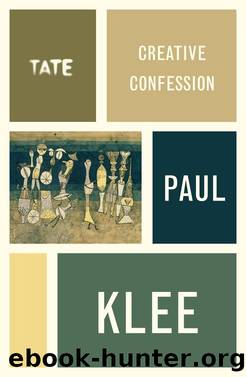Paul Klee by Paul Klee

Author:Paul Klee [Paul Klee]
Language: eng
Format: epub
ISBN: 9781849762670
Publisher: Tate Enterprises Ltd
Published: 2013-08-14T16:00:00+00:00
III
Edschmid’s invitation to Klee on 30 August 1918 confirmed that the painter,[8] who had begun to find an audience during wartime through Herwarth Walden’s Berlin gallery Der Sturm, was a name that the anticipated readership would recognise and find interesting. Within weeks he had completed a first draft of ‘Graphic Art’, as he then called it, although a polished version was not ready until November 1918.[9]
As this was to be his first published reflection on his own art, it is likely that he drew on ideas already noted in his diaries, such as the 1917 passage beginning ‘Thoughts at the open window’.[10] There he observed: ‘Everything we see is a proposal, a possibility, an expedient. The real truth, to begin with, remains invisible beneath the surface.’ Reflecting on his own progress, he added: ‘I had fought my way through formal problems. And now I no longer saw any abstract art. Only abstraction from the transitory remained. The world was my subject, even though it was not the visible world.’ This reflects the sense of the relation between nature and abstraction that Klee attributed to his wartime development.
The retrospective voice here is bound up with Klee’s practice of revising his writings, which was especially prevalent at this moment. The drafts of ‘Creative Confession’ in late 1918 were significantly revised during the extended delay that saw Edschmid’s publication arrive only in early 1920, a delay which bolstered the critical attention around Klee’s exhibition at Hans Goltz’s Munich gallery that May. The propensity to revision was habitual. Around this time, Klee was privately polishing phrases in his diaries, excising immaturities and inserting retrospective observations that transformed the original – which he appears to have destroyed – into a literary rather than an eye-witness endeavour.[11] It is in this spirit that he answers his own question in ‘Creative Confession’ (part IV): ‘Does a pictorial work come into being at one stroke? No, it is constructed bit by bit, just like a house.’
There is little doubt, therefore, that the changes that Klee made to the manuscript were part of a self-conscious awareness of the public importance of this text. Though on a more modest scale, it was equivalent to his friend Wassily Kandinsky’s Concerning the Spiritual in Art that had appeared at the height of the pre-war explosion of avant-gardism in Munich.[12] In this way ‘Creative Confession’ laid out Klee’s position on the triangular relationship between the artist, the response to nature and the artwork in ways that are at once straightforward and idiosyncratic.
Unlike Kandinsky’s broadly sweeping vision of modern art, Klee’s more modest field of action was ‘graphic art’, as indicated in the second sentence: ‘A tendency towards the abstract is inherent in linear expression.’
This was both at Edschmid’s request and broadly how Klee was seen at this period: as an artist primarily concerned with the graphic through draughtsmanship and printmaking. It is notable that he makes explicit the connection between the graphic and the abstract, thus opening up the discussion to the most
Download
This site does not store any files on its server. We only index and link to content provided by other sites. Please contact the content providers to delete copyright contents if any and email us, we'll remove relevant links or contents immediately.
You & Me & Why We Are in Love by Aurelia Alcaïs(3179)
The Four Agreements: A Practical Guide to Personal Freedom (A Toltec Wisdom Book) by Ruiz Don Miguel(2435)
7-14 Days by Noah Waters(2361)
Things Are What You Make of Them: Life Advice for Creatives by Adam J. Kurtz(1816)
Wall and Piece by Banksy(1779)
Post-Impressionism by Nathalia Brodskaya(1677)
Hieronymus Bosch by Virginia Pitts Rembert(1631)
The Thibaults by Roger Martin Du Gard(1571)
The Notebooks of Leonardo Da Vinci by Da Vinci Leonardo(1564)
The Andy Warhol Diaries by Andy Warhol(1560)
Design as Art by Bruno Munari(1553)
The Andy Warhol Diaries by Andy Warhol & Pat Hackett(1516)
Picasso by Gertrude Stein(1505)
Modeling the Head in Clay by Bruno Lucchesi(1479)
Delphi Complete Works of Vincent van Gogh by Vincent van Gogh(1451)
Memory's Wake by Fenech Selina(1442)
Delphi Complete Works of Artemisia Gentileschi (Illustrated) by Artemisia Gentileschi(1438)
Auguste Rodin by Rainer Maria Rilke(1362)
South by Ernest Henry Shackleton(1357)
